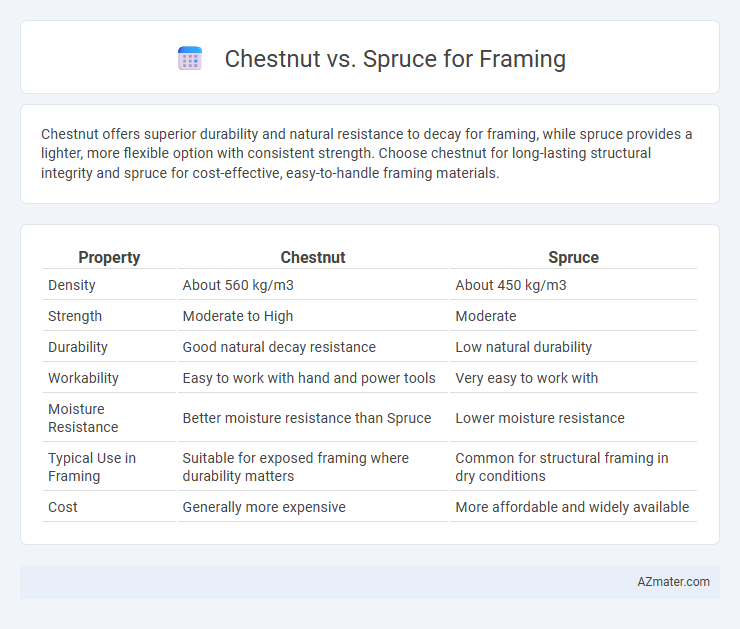Chestnut offers superior durability and natural resistance to decay for framing, while spruce provides a lighter, more flexible option with consistent strength. Choose chestnut for long-lasting structural integrity and spruce for cost-effective, easy-to-handle framing materials.
Table of Comparison
| Property | Chestnut | Spruce |
|---|---|---|
| Density | About 560 kg/m3 | About 450 kg/m3 |
| Strength | Moderate to High | Moderate |
| Durability | Good natural decay resistance | Low natural durability |
| Workability | Easy to work with hand and power tools | Very easy to work with |
| Moisture Resistance | Better moisture resistance than Spruce | Lower moisture resistance |
| Typical Use in Framing | Suitable for exposed framing where durability matters | Common for structural framing in dry conditions |
| Cost | Generally more expensive | More affordable and widely available |
Introduction to Chestnut and Spruce Wood
Chestnut wood, known for its durability and resistance to decay, offers a lightweight yet strong option for framing in construction projects. Spruce, frequently used in framing, provides excellent strength-to-weight ratio coupled with easy workability and cost-effectiveness. Both species exhibit distinct grain patterns and density levels, influencing their structural performance and aesthetic appeal in building frameworks.
Historical Use in Framing
Chestnut wood was highly favored for historical framing due to its natural durability, resistance to decay, and straight grain, which provided structural reliability in early American and European timber framing. Spruce, though less durable than chestnut, gained popularity during the 19th and 20th centuries for its lightweight and consistent strength, making it a cost-effective choice for mass-produced framing lumber. The decline of American chestnut due to blight shifted the primary framing material to spruce and other softwoods, influencing modern construction practices.
Strength and Structural Properties
Chestnut offers moderate strength and good durability, making it suitable for framing in residential construction where moderate loads are expected. Spruce is renowned for its high strength-to-weight ratio and elasticity, providing superior load-bearing capacity and resistance to bending and twisting, which makes it ideal for structural framing in both residential and commercial buildings. Both woods have favorable structural properties, but spruce's higher stiffness and consistent grain pattern make it the preferred choice for critical-load-bearing applications.
Durability and Longevity
Chestnut offers superior natural resistance to decay and insect damage compared to spruce, making it a more durable option for framing in environments prone to moisture and pests. Spruce is lightweight and easier to work with but generally has lower durability, requiring treatment to enhance its longevity in structural applications. For framing that demands long-lasting strength and resilience, chestnut stands out as the preferred choice due to its innate hardness and resistance properties.
Resistance to Pests and Decay
Chestnut wood exhibits high natural resistance to pests and decay due to its tannin content, making it an excellent choice for framing in damp or pest-prone environments. Spruce, while commonly used for framing because of its strength-to-weight ratio, generally requires chemical treatment to achieve similar resistance levels. The inherent durability of chestnut reduces long-term maintenance costs and improves structural longevity compared to untreated spruce.
Workability and Handling
Chestnut offers moderate workability with a fine grain that allows for smooth cutting and nailing but can be prone to splitting without proper pre-drilling. Spruce is highly favored for framing due to its lightweight nature and excellent handling, providing easy sawing, nailing, and fastening with minimal effort. Both woods exhibit reliable structural strength, but spruce's superior ease of handling makes it the preferred choice for large-scale framing projects.
Environmental Impact and Sustainability
Chestnut wood offers superior sustainability due to its fast growth and renewability, making it an eco-friendly option for framing compared to spruce. Spruce, while commonly used for its strength-to-weight ratio, often involves slower growth cycles and higher environmental impact from intensive logging practices. Selecting chestnut supports lower carbon footprints and promotes responsible forestry, aligning with green building standards.
Cost and Availability
Chestnut is generally more expensive than spruce for framing due to its limited availability and slower growth rates, making it a premium choice in niche markets. Spruce is widely available, especially in North America and Europe, offering a cost-effective and readily sourced option for large-scale construction projects. The abundance and faster harvesting cycle of spruce contribute to its lower price point, while chestnut's rarity drives up costs and limits supply.
Aesthetic Qualities
Chestnut wood features a warm, rich color with distinctive grain patterns that bring a rustic, natural charm to framing projects, enhancing visual appeal. Spruce offers a lighter, more uniform appearance with fine, straight grain that provides a clean, modern aesthetic ideal for minimalist or contemporary framing designs. The choice between chestnut and spruce ultimately depends on the desired visual impact, with chestnut providing a bold, textured look and spruce delivering subtle elegance.
Best Applications for Chestnut and Spruce in Framing
Chestnut is best suited for framing due to its natural durability, resistance to decay, and strong load-bearing capacity, making it ideal for exterior structures and heavy timber framing. Spruce is commonly used in framing for its lightweight nature, straight grain, and ease of handling, which suits interior framing and non-load bearing partitions. Choosing between chestnut and spruce depends on the structural demands and environmental exposure of the framing project.

Infographic: Chestnut vs Spruce for Framing
 azmater.com
azmater.com